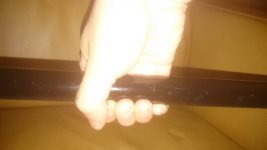Good cueball control is achieved by hitting the cueball where you want, at the correct speed and pocketing the object ball in the precise part of the pocket you wanted. Ok, that wasn't very good, but I think there are ways to help you achieve it.
The grip or hold of the cue has been discussed a lot here on Az, and rightfully so, because any error here will certainly lead to missed shots and bad cueball control. Since I am revising my fundamentals, bit by bit, I have tried every grip I've ever seen described. Some people use mostly the front 2 fingers, others use the middle two primarily and yet others have the cue firmly wedged up in the "webbing" between the thumb and index finger. I even experimented with the "reverse slip" (throwing the cue into the ball). I have discovered a grip, which I think is fairly unique, but I feel it helps me a lot with hitting the cueball precisely.
My thumb rests on the front of the index finger. The cue lies on all 4 finger tips. There is a gap between the cue and the "webbing" between the index finger and the thumb. The finger tips have quite a bit of pressure which pushes the cue up and slightly outward (away from the thumb, and into the middle of the index finger). All the felt pressure is on the fingertips. The middle of the index finger is "passive". I even tried "death gripping" this way, and the results were equally good. The first and middle part of the index finger and thumb are "inert" in that apart from the tip of the index finger they don't apply much pressure to the cue in the sideways direction, they are merely supporting and guiding it. Once you "wedge" the cue up into the hand you are IMO inviting a lot of twisting from the hand/wrist. When you do my grip correctly, you can insert a finger from the other hand between the webbing and the cue, barely.
My grip achieves several things. Since the fingertips are the most sensitive parts of the finger and they are firmly on the cue, they give good feedback. Second, since the thumb and the middle part of the index finger do not pressure the cue, the wrist cannot easily be twisted. Also the stroke movement is not hindered by the pressure. The cue will lightly lift a little bit off the back two fingers on the back on a long swing, but for most shots even these will be in contact. Since there is a gap between the cue and the webbing, the stroke is not constricted in any way.
This might be one of those things that works only for me, but I did teach it to a beginner and he had decent results. Tell me what you think.
The grip or hold of the cue has been discussed a lot here on Az, and rightfully so, because any error here will certainly lead to missed shots and bad cueball control. Since I am revising my fundamentals, bit by bit, I have tried every grip I've ever seen described. Some people use mostly the front 2 fingers, others use the middle two primarily and yet others have the cue firmly wedged up in the "webbing" between the thumb and index finger. I even experimented with the "reverse slip" (throwing the cue into the ball). I have discovered a grip, which I think is fairly unique, but I feel it helps me a lot with hitting the cueball precisely.
My thumb rests on the front of the index finger. The cue lies on all 4 finger tips. There is a gap between the cue and the "webbing" between the index finger and the thumb. The finger tips have quite a bit of pressure which pushes the cue up and slightly outward (away from the thumb, and into the middle of the index finger). All the felt pressure is on the fingertips. The middle of the index finger is "passive". I even tried "death gripping" this way, and the results were equally good. The first and middle part of the index finger and thumb are "inert" in that apart from the tip of the index finger they don't apply much pressure to the cue in the sideways direction, they are merely supporting and guiding it. Once you "wedge" the cue up into the hand you are IMO inviting a lot of twisting from the hand/wrist. When you do my grip correctly, you can insert a finger from the other hand between the webbing and the cue, barely.
My grip achieves several things. Since the fingertips are the most sensitive parts of the finger and they are firmly on the cue, they give good feedback. Second, since the thumb and the middle part of the index finger do not pressure the cue, the wrist cannot easily be twisted. Also the stroke movement is not hindered by the pressure. The cue will lightly lift a little bit off the back two fingers on the back on a long swing, but for most shots even these will be in contact. Since there is a gap between the cue and the webbing, the stroke is not constricted in any way.
This might be one of those things that works only for me, but I did teach it to a beginner and he had decent results. Tell me what you think.




